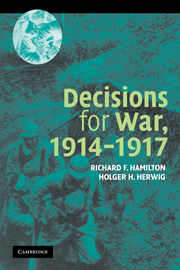Book contents
- Frontmatter
- Contents
- LIST OF MAPS
- MAP 1 General map of Europe: June 1914
- ACKNOWLEDGMENTS
- 1 The Great War: A Review of the Explanations
- 2 European Wars: 1815–1914
- 3 Austria-Hungary
- 4 Germany
- 5 Russia
- 6 France
- 7 Great Britain
- 8 Japan; The Ottoman Empire
- 9 Bulgaria, Romania, and Greece
- 10 Italy
- 11 The United States
- 12 On the Origins of the Catastrophe
- RECOMMENDED READING
- INDEX
1 - The Great War: A Review of the Explanations
Published online by Cambridge University Press: 05 June 2012
- Frontmatter
- Contents
- LIST OF MAPS
- MAP 1 General map of Europe: June 1914
- ACKNOWLEDGMENTS
- 1 The Great War: A Review of the Explanations
- 2 European Wars: 1815–1914
- 3 Austria-Hungary
- 4 Germany
- 5 Russia
- 6 France
- 7 Great Britain
- 8 Japan; The Ottoman Empire
- 9 Bulgaria, Romania, and Greece
- 10 Italy
- 11 The United States
- 12 On the Origins of the Catastrophe
- RECOMMENDED READING
- INDEX
Summary
World War I, once called the Great War, seems to defy explanation. Why did it happen? Numerous books on the subject carry the words “causes” or “origins” in their titles. The literature on the subject is extensive, probably the largest for any war in human history.
To address that basic question, a review of wars over the previous three centuries proves useful. And for this purpose a key term, world war, needs definition. We define a world war as one involving five or more major powers and with military operations on two or more continents. Since central Europe tore itself apart during the Thirty Years' War (1618–48), eight wars fit this definition. They are the War of the Grand Alliance, 1689–97; the War of the Spanish Succession, 1701–14; the War of the Austrian Succession, 1740–48; the Seven Years' War, 1756–63; the French Revolutionary Wars, 1792–1802; the Napoleonic Wars, 1803–15; then, after a ninety-nine-year interlude, World War I, 1914–18; and, two decades later, World War II, 1939–45. Following our definition and within this time span, the “Great War” was actually World War VII.
Those wars were massive and destructive. We have one crude measure of their “intensity,” defined as “total battle fatalities suffered by the involved great powers per million of European population.” Of the first six struggles, the Napoleonic Wars (1803–15) were by far the largest, with a fatality rate of 16,112. By this measure, the Great War was much more destructive at 57,616.
- Type
- Chapter
- Information
- Decisions for War, 1914–1917 , pp. 1 - 22Publisher: Cambridge University PressPrint publication year: 2004



